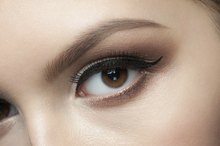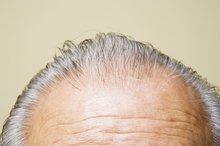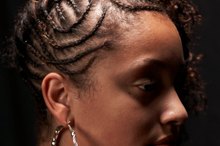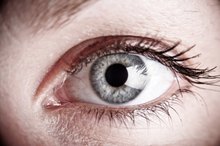The widow’s peak is a classic sign of male-pattern baldness, or androgenetic alopecia. In this condition, the front hairline recedes at both corners, resulting in the M-shaped front hairline known as a widow’s peak. Men as young as 20 can begin to recede at the temples and thin in the crown. The condition progresses with age; men in advanced stages are usually completely bald on top of their head with a little bit of hair left growing around the base of the skull.
Cause
Dihydrotestosterone (DHT) causes 95 percent of hair-loss cases, according to Medical News Today 2. DHT, a byproduct of the male hormone testosterone, builds up in the scalps of people genetically predisposed to hair loss. The presence of DHT leads to hair loss in a couple of ways. First, DHT blocks vital nutrients from getting to the dermal papilla, the hair follicle structure responsible for hair growth. Inadequate nutrition causes slow hair growth and shortens the growing phase or lengthens the resting stage of individual hairs, resulting in hair loss. DHT also shrinks hair follicles, causing hair to become thinner in diameter. Eventually, follicles shrink until the hair falls off, and the follicle becomes permanently dormant.
- Dihydrotestosterone (DHT) causes 95 percent of hair-loss cases, according to Medical News Today 2.
- DHT also shrinks hair follicles, causing hair to become thinner in diameter.
Heredity
Greasy & Thinning Hair
Learn More
Heredity predisposes a person to produce DHT in excessive amounts. Both parents determine the genetic predisposition for baldness. Chances increase commensurately with the number of balding men and women in your family tree.
Treatment
Two main treatments exist for androgenetic alopecia. Minoxidil, an over-the-counter topical treatment, helps some people slow the progression of hair loss and, in some cases, grow new hair. Finasteride, an oral medication available by prescription, has more success at slowing loss and increasing growth, but it has several side effects, including diminished sexual function. Any progress made with either of these treatment options completely reverses once treatment is stopped.
- Two main treatments exist for androgenetic alopecia.
- Minoxidil, an over-the-counter topical treatment, helps some people slow the progression of hair loss and, in some cases, grow new hair.
Surgery
How to Make Your Eyebrows Thicker
Learn More
Popular surgical procedures include hair transplants and scalp reduction. Transplant procedures involve taking hair from the back of the head and moving it to balding areas where it is hoped that it will grow and thrive. Scalp reduction removes the balding portion of scalp and stretches the scalp that does grow hair to cover the portion of the missing scalp. Sometimes, both procedures are used to create a natural look. Always consult your doctor if you're experiencing hair loss, to determine the best treatment plan for you.
- Popular surgical procedures include hair transplants and scalp reduction.
- Transplant procedures involve taking hair from the back of the head and moving it to balding areas where it is hoped that it will grow and thrive.
Style
Several men’s hairstyles work perfectly with a widow’s peak. Short clipper styles such as the old-fashioned barber’s flattop, the military fade and the classic fade with a pushed-up bang all hide receding temples. If the progression is slight, wearing a full bang will pull hair down over the thinning areas.
Related Articles
References
- Medical News Today: What Is DHT?
- Phillips TG, Slomiany WP, Allison R. Hair Loss: Common Causes and Treatment. Am Fam Physician. 2017;96(6):371-378.
- Watras MM, Patel JP, Arya R. Traditional anticoagulants and hair loss: a role for direct oral anticoagulants? A review of the literature. Drugs Real World Outcomes. 2016;3(1):1-6. doi:10.1007/s40801-015-0056-z
- Urysiak-czubatka I, Kmieć ML, Broniarczyk-dyła G. Assessment of the usefulness of dihydrotestosterone in the diagnostics of patients with androgenetic alopecia. Postepy Dermatol Alergol. 2014;31(4):207-15. doi:10.5114/pdia.2014.40925
- Vincent M, Yogiraj K. A descriptive study of alopecia patterns and their relation to thyroid dysfunction. Int J Trichology. 2013;5(1):57-60. doi:10.4103/0974-7753.114701
- Peters EMJ, Müller Y, Snaga W, et al. Hair and stress: A pilot study of hair and cytokine balance alteration in healthy young women under major exam stress. PLoS ONE. 2017;12(4):e0175904. doi:10.1371/journal.pone.0175904
- Pratt CH, King LE, Messenger AG, Christiano AM, Sundberg JP. Alopecia areata. Nat Rev Dis Primers. 2017;3:17011. doi:10.1038/nrdp.2017.11
- American Academy of Dermatology. Alopecia Areata: Overview.
Writer Bio
Kathy Mayse began her writing career as a reporter for "The Jackson-County Times Journal" in 2001. She was promoted to assistant editor shortly after. Since 2005, she has been busy as a successful freelancer specializing in Web content. Mayse is a licensed cosmetologist with more than 17 years of salon experience; most of her writing projects reflect this experience.









